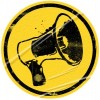Facial Resonance and Twang
 One of the most important skills an actor, or any public speaker, can learn is to enhance the sensation of vibration in their face. When you feel vibrations in the bones of your face, then you're using your voice in an effective way that creates loud sound with little effort, and less risk of damage to your vocal folds. We want to turn the energy of your breath into sound energy with as little muscle effort as possible, which should turn your head into a sound box that amplifies the sound of your folds so you can be heard by lots of people in a large space.
One of the most important skills an actor, or any public speaker, can learn is to enhance the sensation of vibration in their face. When you feel vibrations in the bones of your face, then you're using your voice in an effective way that creates loud sound with little effort, and less risk of damage to your vocal folds. We want to turn the energy of your breath into sound energy with as little muscle effort as possible, which should turn your head into a sound box that amplifies the sound of your folds so you can be heard by lots of people in a large space.
Singers have called this "resonating the mask" for centuries, and if you have some classical singing experience, what we do here today will help you cross that singing experience over to speaking. Probably the most important elements of getting effective resonance in your voice are in getting your breath to help you, and to "listen" to the sensations of your body to make subtle adjustments in order to tune how your articulators, that's your tongue, jaw, lips and soft palate, shape the sound coming from your larynx.
We've done a little exploration of resonance on The VoiceGuy, in particular in the posts Resonance Basics and Chest Resonance. This step in the Advanced Warm-up Series could be considered the second part of what began in Chest Resonance, again, modeled after the Linklater exercise "Freeing the Channel." We'll do this one in several parts, spread over several days. Today we'll begin with feeling the buzz.
Step One: Enhancing the Sensation through your Nose
We'll begin by trying to get as much sensation in the face as possible. Nasal sounds are probably the easiest sounds to make that generate a lot of sensation in the bones and tissues of the face. Start by making an "ng" sound (IPA [ŋ]) and see what you can feel. You will probably feel vibrations where the back of your tongue meets your soft palate. Perhaps you will also feel vibration in the bones of your face and in your hard palate. Now try the other two nasal consonants, "m" and "n." Do you feel the vibration in different places? By comparing the three sounds, you should notice that the contact places for each sound is different (back of tongue, tongue tip and your two lips), so you'll feel more in those contact places. But also, the bones of your face will respond differently. Which one is buzziest for you?
Now try using your fingertips to feel the vibrations. Keep the note or pitch the same all the way through and alternate slowly between the three nasal consonants: [ŋ n m n ŋ n m n ŋ n m n ŋ n m n…] Can you feel the vibrations in your nose? In the bones of your face? Next, try opening up your mouth and make a nasal vowel sound. I would recommend the sound in "cat"(IPA [æ̃]). Try combining it with an [ n ] or [ ŋ]. Some people find the "ee" vowel, as in "feet" (IPA [i]) to be even more open to feeling vibration, especially when it is a nasal sound.
In our next post, we'll move out of the nasal sounds and into oral sounds.
Next Step: Facial Resonance and Twang Part 2